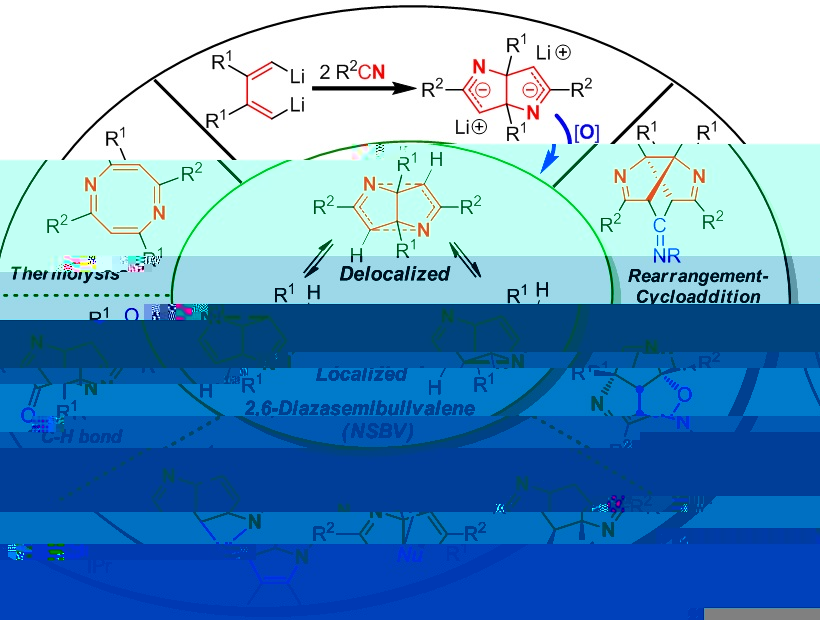研究室工作進展 Jun. 15th, 2015
Semibullvalene and Diazasemibullvalene: Recent Advances in the Synthesis, Reaction Chemistry, and Synthetic Applications
Shaoguang Zhang, Wen-Xiong Zhang, and Zhenfeng Xi*
Acc. Chem. Res. 2015, DOI:10.1021/acs.accounts.5b00190

Semibullvalene (SBV) and its aza-analogue 2,6-diazasemibullvalene (NSBV) are both theoretically interesting and experimentally challenging organic molecules because of four unique features: highly strained ring systems, intramolecular skeletal rearrangement, extremely rapid degenerate (aza)Cope rearrangement, and predicted existence of neutral homoaromatic delocalized structures. SBV has received much attention in the past 50 years. In contrast, since NSBV was predicated in 1971 and the first in situ synthesis was realized in 1982, no progress on NSBV chemistry was made until our results in 2012. We have been interested in reaction chemistry of 1,4-dilithio-1,3-butadienes (dilithio reagents for short), especially for its application in synthesis of SBV and NSBV. This is because: i) the cyclodimerization of dilithio reagents could provide the potential 8-carbon skeleton of SBV from butadiene 4-carbon unit, and ii) the insertion reaction of dilithio reagents with C≡N bonds of two nitriles could provide the (6-C+2-N) skeleton which might be a good precursor for the synthesis of NSBV. Therefore, we initiated a journey to the synthesis and reaction chemistry of SBV and NSBV starting from dilithio reagents since 2006. In this Account, we outline mainly our recent achievement on the synthesis, structural characterization, reaction chemistry, synthetic application, and theoretical/computational analysis of NSBV.
Two efficient synthetic strategies for NSBV from dilithio reagents and nitriles via oxidant-induced C-N bond formation will be introduced. The structural investigation of NSBV, including X-ray crystal structure, determination of the activation barrier of aza-Cope rearrangement, and theoretical analysis, shows that the localized structure of NSBV is the predominant form, and the homoaromatic, delocalized structure exists as a minor component in the equilibrium. Then we will introduce the reaction chemistry and synthetic applications of NSBV. Several novel reaction patterns were explored including thermolysis, C-N bond insertion, rearrangement-cycloaddition, oxidation and nucleophilic ring-opening reaction. Diverse and interesting N-containing polycyclic skeletons could be constructed, such as nickelaazetidine, 1,5-diazatriquinacenes and triazabrexadienes, which are not available by other means.
Our results show that NSBV not only features rapid (aza)Cope rearrangement with low activation barrier, but also acts as unique synthetic reagent, which is significantly different from aziridine. The strained rigid ring systems as a whole could be involved in the reactions. Our achievement highlights two significant progresses: i) The well-established efficient synthesis and isolation of NSBV greatly accelerate the development of NSBV chemistry, and ii) The previously unattainable molecules have become “normal” and routine starting materials for the synthesis of otherwise unavailable but interesting structures. We expect our pursuits will inspire and help direct future efforts on chemical and physical research of NSBV.
亮點介紹
半瞬烯(Semibullvalene)和氮雜半瞬烯(Diazasemibullvalene)具有稠合的多個高張力環骨架、可以發生快速科普(Cope)重排、理論預測最有可能實現中性同芳香性(homoaromaticity),因此,在2000年前的近半個世紀中曾經引起物理有機化學家和有機合成實驗化學家的極大關注,是有機化學中的“明星”分子,在有機化學中具有特殊意義。但是,與半瞬烯的活躍研究報道相比,氮雜半瞬烯的合成方法、結構、反應與應用知之甚少,在本組的近期工作報道之前幾乎一無所知。
2006年本組王超同學利用本組自己發展的雙锂試劑(注:本組發展的3個雙锂試劑已經被J&K百靈威科技公司商品化并上市銷售),在CuCl的促進下發生分子間自由基環化二聚,首次實現了金屬促進的多取代半瞬烯的合成(JACS 2006)。該工作使我們有機會了解了半瞬烯和氮雜半瞬烯的研究曆史、科學意義和研究現狀。在此基礎上,我們開展了更有挑戰性的氮雜半瞬烯的合成研究。經過多位同學曆經5年多的探索,最終于2012年由張韶光同學再次利用本組發展的雙锂試劑的協同效應,建立了高效合成該類分子的2種方法,首次測定了該類分子的活化能和單晶結構,發現了該類分子的多種化學反應類型。該項研究結果表明該類分子存在中性同芳香性,為進一步的實驗研究奠定了基礎(JACS 2012,該文被選為JACS Spotlights)。進一步地,張韶光等同學開展了該類化合物的結構和反應性關系研究,發現了新的反應類型,利用該類化合物多個高張力環骨架的協同效應,“牽一發而動全身”,實現了一些具有特殊結構如碗狀或空腔分子的合成(ACIE 2013, CC 2013, CEJ 2014, OCF 2014, CAJ 2015, OL 2015)。
該創新性、系統性工作建立在本組雙金屬有機合成試劑化學(ACR 2010) 的基礎之上,是本組一直秉承的“基于活性中間體和機理研究的合成化學”研究方法(W.-X. Zhang and Z. Xi, Org. Chem. Front. 2014, 1, 1132)的成果之一。
該文是本組第三次在ACR期刊上介紹本組創新性和系統性工作。2010年ACR期刊介紹了本組的雙金屬有機合成試劑化學,2011年ACR期刊介紹了本組的金屬有機雜環試劑化學。
